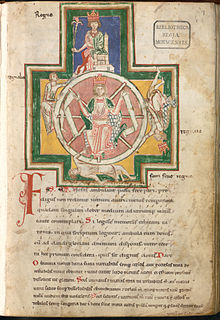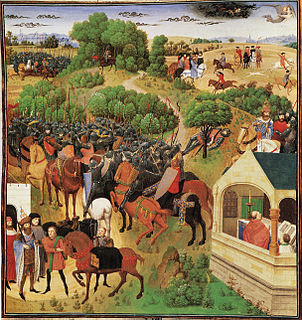Related Research Articles

An epic poem is a lengthy narrative poem, ordinarily involving a time beyond living memory in which occurred the extraordinary doings of the extraordinary men and women who, in dealings with the gods or other superhuman forces, gave shape to the mortal universe for their descendants, the poet and his audience, to understand themselves as a people or nation.

Lyric poetry is a formal type of poetry which expresses personal emotions or feelings, typically spoken in the first person. It is not equivalent to song lyrics, though they are often in the lyric mode. The term derives from a form of Ancient Greek literature, the lyric, which was defined by its musical accompaniment, usually on a stringed instrument known as a lyre. The term owes its importance in literary theory to the division developed by Aristotle between three broad categories of poetry: lyrical, dramatic, and epic.

The goliards were a group of clergy, generally young, in Europe who wrote satirical Latin poetry in the 12th and 13th centuries of the Middle Ages. They were chiefly clerics who served at or had studied at the universities of France, Germany, Spain, Italy, and England, who protested against the growing contradictions within the church through song, poetry and performance. Disaffected and not called to the religious life, they often presented such protests within a structured setting associated with carnival, such as the Feast of Fools, or church liturgy.
British literature is literature from the United Kingdom of Great Britain and Northern Ireland, the Isle of Man, and the Channel Islands. This article covers British literature in the English language. Anglo-Saxon literature is included, and there is some discussion of Latin and Anglo-Norman literature, where literature in these languages relate to the early development of the English language and literature. There is also some brief discussion of major figures who wrote in Scots, but the main discussion is in the various Scottish literature articles.
Sagas are prose stories and histories, composed in Iceland and to a lesser extent elsewhere in Scandinavia.

The chanson de geste is a medieval narrative, a type of epic poem that appears at the dawn of French literature. The earliest known poems of this genre date from the late eleventh and early twelfth centuries, before the emergence of the lyric poetry of the trouvères (troubadours) and the earliest verse romances. They reached their highest point of acceptance in the period 1150–1250.
A chanson is in general any lyric-driven French song, usually polyphonic and secular. A singer specializing in chansons is known as a "chanteur" or, if a woman, a "chanteuse"; a collection of chansons, especially from the Middle Ages or Renaissance, is a chansonnier.

A knight-errant is a figure of medieval chivalric romance literature. The adjective errant indicates how the knight-errant would wander the land in search of adventures to prove his chivalric virtues, either in knightly duels or in some other pursuit of courtly love.
A minstrel was a medieval European entertainer. Originally describing any type of entertainer such as a musician, juggler, acrobat, singer or fool, the term later, from the sixteenth century, came to mean a specialist entertainer who sang songs and played musical instruments.

Ancient Greek literature is literature written in the Ancient Greek language from the earliest texts until the time of the Byzantine Empire. The earliest surviving works of ancient Greek literature, dating back to the early Archaic period, are the two epic poems The Iliad and The Odyssey, set in an idealized archaic past today identified as having some relation to the Mycenaean era. These two epics, along with the Homeric Hymns and the two poems of Hesiod, Theogony and Works and Days, comprised the major foundations of the Greek literary tradition that would continue into the Classical, Hellenistic, and Roman periods.

Medieval French literature is, for the purpose of this article, Medieval literature written in Oïl languages during the period from the eleventh century to the end of the fifteenth century.

Medievalism is a system of belief and practice inspired by the Middle Ages of Europe, or by devotion to elements of that period, which have been expressed in areas such as architecture, literature, music, art, philosophy, scholarship, and various vehicles of popular culture. Since the 18th century, a variety of movements have used the medieval period as a model or inspiration for creative activity, including Romanticism, the Gothic revival, the pre-Raphaelite and arts and crafts movements, and neo-medievalism.
Middle Dutch literature (1150–1500) is the Dutch literature produced in the Low Countries from the 12th century up to the sixteenth century. It is preceded by only a few fragmentary texts existing in Old Dutch, and it was succeeded by Dutch Renaissance and Golden Age literature.

Literature broadly is any collection of written work, but it is also used more narrowly for writings specifically considered to be an art form, especially prose fiction, drama, and poetry. In recent centuries, the definition has expanded to include oral literature, much of which has been transcribed. Literature is a method of recording, preserving, and transmitting knowledge and entertainment.
This article is focused on English-language literature rather than the literature of England, so that it includes writers from Scotland, Wales, the Crown dependencies, and the whole of Ireland, as well as literature in English from countries of the former British Empire, including the United States. However, until the early 19th century, it only deals with the literature of the United Kingdom, the Crown dependencies and Ireland. It does not include literature written in the other languages of Britain.
King Rother or König Rother[ˈkøːnɪk ˈʁoːtɐ] is the earliest Spielmannsdichtung known to historians. It has many of the qualities of a fairy tale. Only one complete manuscript exists from the twelfth century. The tale was popular into the fourteenth century. The name Rother may have a connection to a king of the Lombards, Rothari. There is a possibility, however, the name Rother may have come from the Norman king, Roger II of Sicily.

Der wilde Alexander, also known as Meister Alexander, was a medieval Minnesänger who was active from the mid-1200s until after 1288. His works are considered to be part of the Sangspruchdichtung.
Middle High German literature refers to literature written in German between the middle of the 11th century and the middle of the 14th. In the second half of the 12th century, there was a sudden intensification of activity, leading to a 60-year "golden age" of medieval German literature referred to as the mittelhochdeutsche Blütezeit (1170–1230). This was the period of the blossoming of MHG lyric poetry, particularly Minnesang. The same sixty years saw the composition of the most important courtly romances. These are written in rhyming couplets, and again draw on French models such as Chrétien de Troyes, many of them relating Arthurian material. The third literary movement of these years was a new revamping of the heroic tradition, in which the ancient Germanic oral tradition can still be discerned, but tamed and Christianized and adapted for the court. These high medieval heroic epics are written in rhymed strophes, not the alliterative verse of Germanic prehistory.

Music in Medieval Scotland includes all forms of musical production in what is now Scotland between the fifth century and the adoption of the Renaissance in the early sixteenth century. The sources for Scottish Medieval music are extremely limited. There are no major musical manuscripts for Scotland from before the twelfth century. There are occasional indications that there was a flourishing musical culture. Instruments included the cithara, tympanum, and chorus. Visual representations and written sources demonstrate the existence of harps in the Early Middle Ages and bagpipes and pipe organs in the Late Middle Ages. As in Ireland, there were probably filidh in Scotland, who acted as poets, musicians and historians. After this "de-gallicisation" of the Scottish court in the twelfth century, a less highly regarded order of bards took over the functions of the filidh and they would continue to act in a similar role in the Scottish Highlands and Islands into the eighteenth century.

Romanticism was an artistic, literary, and intellectual movement that originated in Europe toward the end of the 18th century. Scholars regard the publishing of William Wordsworth's and Samuel Coleridge's Lyrical Ballads in 1798 as probably the beginning of the movement, and the crowning of Queen Victoria in 1837 as its end. Romanticism arrived in other parts of the English-speaking world later; in America, it arrived around 1820.
References
- ↑ Garland, Henry; Garland, Mary (1997), "Spielmannsdichtung", The Oxford Companion to German Literature, Oxford University Press, ISBN 978-0-19-815896-7,
Spielmannsdichtung: formerly accepted as a generic term for a number of medieval German epics of adventurous and ‘popular’ character.